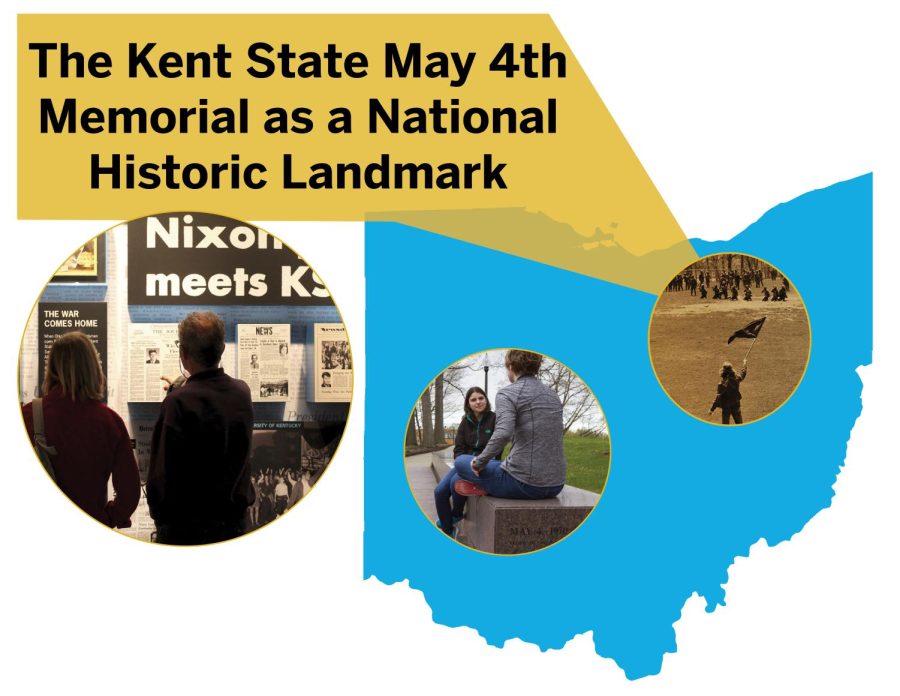May 4 Visitor’s Center becomes National Landmark
January 11, 2017
The Secretary of The Interior, Sally Jewell, designated Kent State’s May 4 Visitor’s Center as a National Historic Landmark on Wednesday, part of a National Park Service program to recognize significant places.
The center has been a part of the Park Service’s National Register of Historic Places since 2010 — but the new designation is even more selective.
“The national landmark designation is much harder to attain than the register of historic places. Rarer still is to receive the status before the 50th commemoration,” said Mindy Farmer, director of the May 4 Center.
There are about 90,000 places recognized as part of the National Register of Historic Places, according to the National Park Service. Of these, just over 2,500 places are Historic Landmarks approved by the nation’s secretary of the interior.
“It is a permanent reminder that students are agents of change, the First Amendment is sacred and peace is better than war,” Farmer said. “These lessons are as important today as they were more than 40 years ago.”
To be selected as a National Historic Landmark, a site should, according to the Park Service, “possess exceptional value or quality in illustrating or interpreting the heritage of the United States” — attributes that those who prepared the nomination agree the site possesses.
“There were a number of things that resulted from the May 4, 1970, shooting … it had a big impact on the country as a whole … it was responsible for the largest student strike in United States history, and in many people’s estimation, this really turned the tide in terms of protest against the Vietnam war,” professor emeritus Mark Seeman said.
Seeman, who primarily authored the nomination with fellow emeritus professor Laura Davis, was required to contextualize the May 4 tragedy alongside others in United States history in order for the site to be considered — something that he had previously undertaken alongside fellow professors emeritus Davis, Jerry M. Lewis and the late Carole Barbato when applying for the National Register of Historic Places.
“The processes are similar in terms of the actual forms and requirements, but what’s different is that for the National Historic Landmark program, you have to put the site in a much broader context, so you have to explicitly compare the events, in this case of May 4 and what happened here, with other historic sites,” Seeman said. “In most cases, things in United States history where unfortunately there was a tragic element.”
After writing the nomination, Seeman, Davis and provost and senior vice president of Academic Affairs Todd Diacon presented to the Landmark Committee in November 2016.
“It was a process of sort of contextualizing … the student protest movement within this larger arc of significant protests and tragedies of Unites States history, for purpose of nomination,” Seeman said.
Work put forth for the long nomination process, in progress since 2014, included input from many in the Center, including Farmer, Seeman, Davis, Bradley Keefer, Lori Boes, Lewis and archivists Lae’l Hughes Watkins and Cara Gilgenbach.
Ohio Sen. Sherrod Brown also joined in the effort, writing to the National Park Service in 2016 in support of the designation.
“The May 1970 shooting at Kent State marked an important moment in our nation’s history, galvanizing student activism nationwide during the Vietnam War and providing a chilling testament to the power of the right to protest. Our nation will never forget the images of that day and this designation will ensure that Kent State’s place in American history will be recognized for years to come,” Brown said in a statement released on his website Wednesday afternoon.
Those involved in the process were notified just yesterday that the nomination had been approved.
“One of the reasons why this is so important is that it’s going to draw more people to the actual site. I mean, that’s really the goal of the National Landmarks program … for members of the public to get out to all of these places and learn about the history in the place that they happened,” Davis said. “When people come to Kent, when they come on campus, when they go through the May 4 Visitor’s Center … and follow the May 4 walking tour — which also follows the history — they are going to see the history in its locale and even see how the very contours of the land contributed to how the story unfolded as it did.”
Cameron Gorman is a senior reporter, contact her at [email protected].












